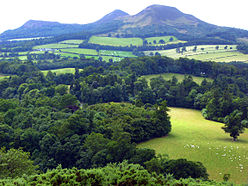Trimontium (Newstead)
| Trimontium | |
|---|---|

Site of Trimontium with the three peaks of Eildon Hill in the background
|
|
| Coordinates | 55°36′04″N 2°41′13″W / 55.601°N 2.687°W |
| Town | Melrose |
| County | Scottish Borders |
| Country | Scotland |
| UK-OSNG reference | NT569344 |
Trimontium is the name of a Roman fort at Newstead, near Melrose, Scottish Borders, Scotland, close under the three Eildon Hills (whence the name trium montium). It was an advance post of the Romans in the Roman province of Valentia. The fort was identified by Ptolemy in his Geography. Trimontium was occupied by the Romans intermittently from 80 to 211. The fort was likely abandoned from c. 100-105 AD until c. 140 AD. At the height of the Roman occupation of the fort, no more than 1500 soldiers and a smaller civilian population lived in the settlement.
The fort was laid out as a standard Roman fort. It has three layers of defences, the first being the central fort itself with its earthen defences built during the 1st century. The second layer is a series of four ditches built during the last part of the 2nd century. There is an additional series of walls and trenches in the west annex.
In addition to the standard Roman defences and fort, which include a Roman bath and mansio built during a major expansion in 86 AD, the Romans built other structures. Chief amongst these was an amphitheatre excavated in 1996, which could have held between 1000-2000 people, smaller than many other Romano-British amphitheatres.
The main road to the fort led directly west from the main fort. An additional north-south road ran along the outskirts of the fort.
Excavations by James Curle between February 1905 and September 1910 began the first exploration of the site, making many findings. These include the foundations of several successive forts, one above the other, which throw much light on the character of the Roman military post; an unparalleled collection of Roman armour, including ornate cavalry parade (or 'sports') helmets (Newstead Helmet), horse fittings including bronze saddleplates and studded leather chamfrons, a good series of Roman coins and some datable pottery. The whole illustrates the history of the Roman army and that of the Roman military occupation of southern Scotland very remarkably. The cavalry unit stationed at Trimontium, ala Augustae Vocontiorum had been raised among the Vocontii of southern Gaul.
...
Wikipedia

